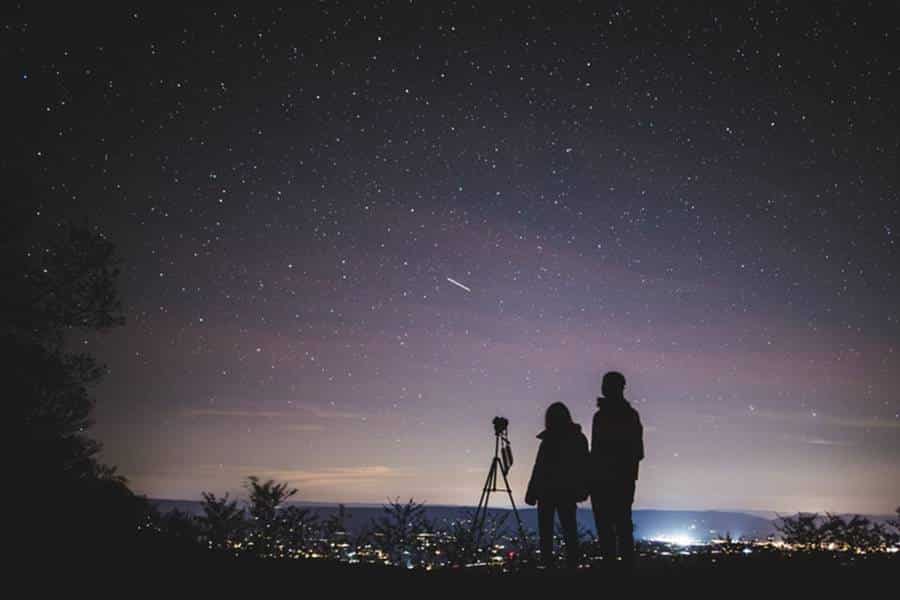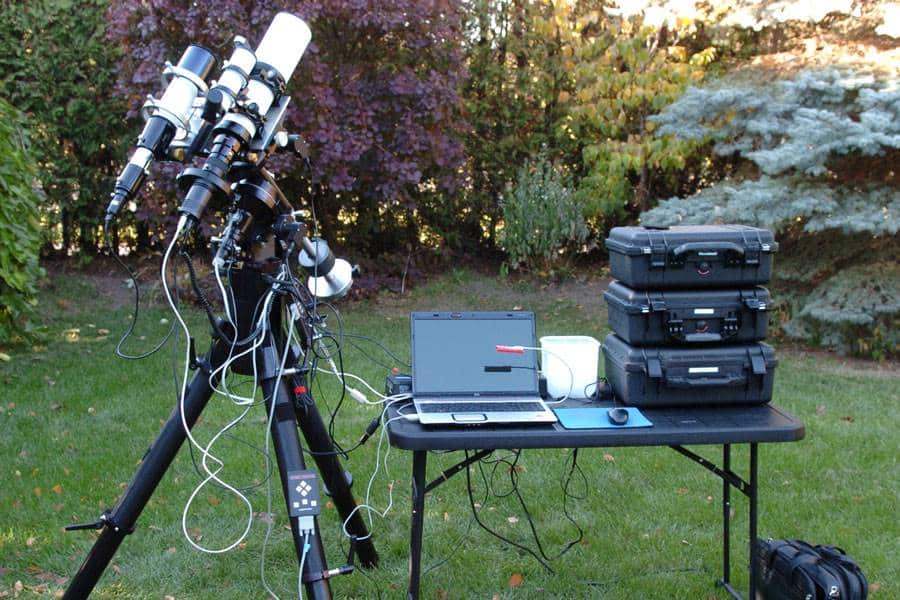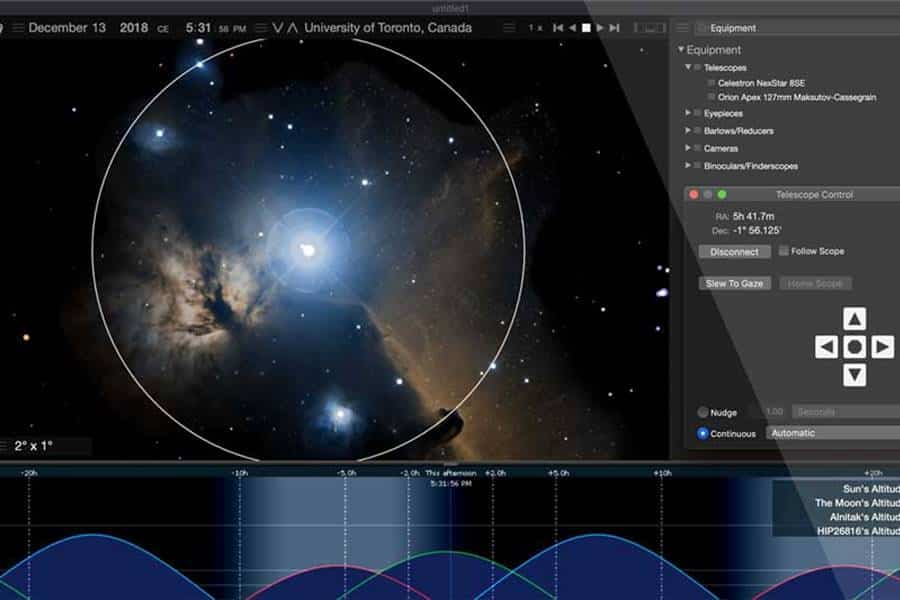Today we are going to discuss the top 10 telescopes for astrophotography. We are looking at the sky since the time of the Neanderthals. Nowadays (more precisely, at night), you do not need to be the owner of your observatory to see with your own eyes what is hidden in the sky from the naked eye.
The choice of viewing the starry sky and the good telescopes for home is quite broad. In addition, there are now much more interesting objects in the sky for observation: which of your friends can boast that he saw the ISS with his own eyes? Well, a telescope, albeit with just one eye, will allow that too. The best telescopes for observing stars and planets from home are presented in my today’s article.
The main thing is to choose a telescope that suits your lens of design and quality of craft. It is of particular importance in our latitudes: the best time for observing the starry sky is winter nights, so reliable protection against fogging and general “frost resistance” are necessary for a telescope.
Content:
- Best Refractor Telescopes
- Best Reflective (Mirror) Telescopes
- Best Catadioptric Telescopes
- Best Chromospheric Telescopes
- Which Telescope Should You Buy?
Best Telescopes for Astrophotography

Best Refractor Telescopes
A refractor (from the English word refract) is a lens telescope built on the principle of light refraction. In such devices, the magnification effect is achieved through the use of lenses that refract light. The design is quite simple; therefore, refractors can differ in price favorably against the background of other types (without considering specific nuances and characteristics).
The telescope tube is completely closed on both sides by the lens and the eyepiece, so dust, debris, and moisture do not get inside. The design is robust, making this telescope ideal for beginners and children.
It is well suited for long journeys in a car trunk. Below are the two best refractor telescopes chose by expert astrophotographers.
1. Meade Star Navigator NG 102mm
Meade Star Navigator NG 102 opens our rating of the best telescopes for observing stars and planets. The American company Meade Instruments is now considered one of the largest manufacturers of telescopes.
Well, they have a lot to choose from, and the new “Star Navigator” is undoubtedly an exciting telescope, which comes complete with wired remote control, an alt-azimuth mount Star Navigator NG, two eyepieces (9 and 26 mm), and an oblique prism.
The mount supports auto-guidance, which will be appreciated by astrophotography enthusiasts as well.

The refractor, which has a focal length of 660mm, is equipped with a 102mm lens: as a result, the relative aperture is not even decent, but excellent (f/6.5), and the dimensions with the weight of the telescope can still be kept acceptable – everything weighs 6.5 kg. So, that has no significant problems with portability. The maximum magnification is 300 times, although it is already somewhat “soapy.”
The electronics are powered by 8 AA batteries and can also be connected to a power adapter or car battery. The updated database contains about 30 thousand objects, from the solar system’s planets to 15 periodic comets and more than 16 thousand stars. The presence of a search function in the database and a built-in “guide” will appeal to beginners, but in general, the telescope is quite worthy and has the right to belong to the “average” level.
Astrophotography enthusiasts can easily “pair” a telescope with a camera using the T-adapter with M42 thread on the eyepiece mount. However, hanging a heavy “SLR” on a telescope, you already definitely understand that a tripod is still flimsy for the sake of lower prices and weight reduction, although for this price segment, it is strange to expect stability from it as at an observatory.
Buy Meade StarNavigator NG 102mm on Amazon for $798 Today.
Review
Under astrophotography with a tripod, you need to conjure, but in general, for your money, an exciting option.
Pros:
- Good Luminosity
- Automatic PRY Drive
- Rich Equipment
- Convenient Transportation
Cons:
- It will take a long time to deal with the remote control.
2. BRESSER AR 102/600 EQ3
This telescope, which has an aperture of f/5.5 with a 90mm lens, inevitably has a not-so-impressive zoom-up to 180x. However, for many observations, this will be enough, except that looking for traces of aliens on Mars with a resolution of one and a half arc seconds (this is still not enough in comparison with the same Meade, with a higher magnification that fits into 1.3 arc seconds) will be a so-so idea.
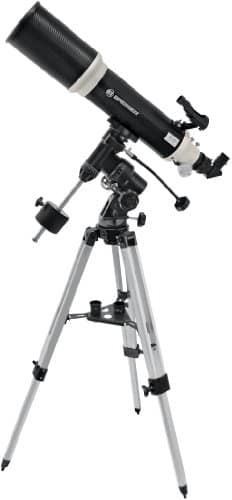
Mount – no automation, equatorial. Nominally, the telescope comes with only one eyepiece, 26 mm (according to the Super-Plossl Scheme). It is worth buying one more – “shorter” in focal length. Tripod – aluminum, with leg supports separately adjustable for installation on uneven surfaces. The viewfinder is 6x with a 30mm lens.
It is worth noting that the telescope is still somewhat expensive ($444). However, it is designed primarily for beginners and “advanced beginners” (and then they may wonder – why not look for a model with a motorized mount?).
The target audience is hinted at by the presence of an adapter for smartphones in the kit – you know, for more or less serious astrophotography, you need a standard camera. And if you consider that separately this adapter from Bresser is not cheap, we think it would be more logical to remove it from the kit, thereby making it more affordable and more attractive. Or put in its place a cheaper T-Ring, which is more beneficial for the photographer.
Buy BRESSER AR 102/600 EQ3 on Amazon for $444 Today.
Review
Generally, I liked it, but the price is a little bit high. Price starts from $444 on major online platforms.
Pros:
- Good luminosity
- Decent rig rigidity
Cons:
- High price
- Only one eyepiece included
The Best Reflective (Mirror) Telescopes
Reflector (from English reflect) is also a mirror telescope built on a different principle. It is based on reflective mirrored optical elements. Usually, there are two of them: one concave mirror and one diagonal. This design is more inconsistent than that of a refractor, but it also has several advantages.
For example, the most significant drawback of a lens telescope is a chromatic aberration in the image, which gives the effect of coloring the edges of the observed objects. Due to its design, a specular telescope is free from chromatic aberration. Therefore it provides an image of an object without any color anomalies. It also has one crucial advantage: a telescope is more compact with the same technical characteristics.
But there is a nuance: a mirror telescope requires much more careful handling. It is not protected from the ingress of foreign particles, is more fragile, and therefore less suitable for long trips. Such a telescope is preferable for detailed observations and is ideal for experienced astronomy enthusiasts. Below are the two best reflective (mirror) telescopes selected by experts you can buy for astrophotography at home.
1. Sky Watcher Quattro 12-inch Reflector
The Newtonian reflector 400 fold with a 200 mm aperture and the Sky-Watcher EQ6-R auto-guidance system will please both the image quality and the possibilities. True, heating will not hurt it to collect: after all, our winter nights are cold for it.
A parabolic mirror is used here, giving excellent image clarity. Given the high aperture ratio (f/5), we can count on the fact that the depths of the sky already studied by other telescopes will be able to reveal something new.
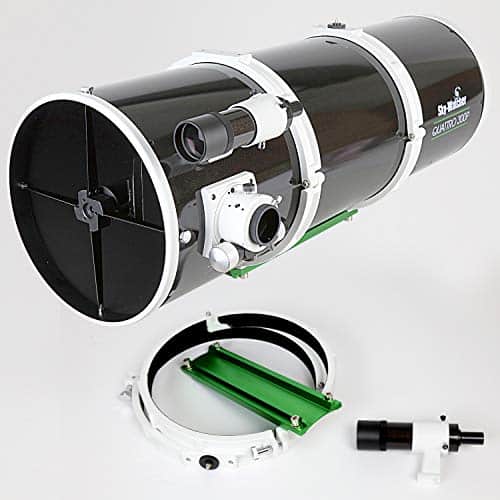
Taking distant galaxies at the maximum magnification insight, one can understand that the mount’s stability is no longer enough – this is also why we mentioned that it is not worth chasing the magnification. But it cannot be said that this greatly spoils the impression of using the telescope.
As for the auto-tracking/object tracking system, we have already described it above, and there is no point in repeating it – here, it is identical to the one used on the Sky-Watcher EQ6-R (eh, to make a mount here).
Please note that thermal stabilization for this telescope (as for all reflectors with a massive mirror) is essential – you should immediately familiarize yourself with proven solutions on the forums.
Buy Sky-Watcher Quattro on Amazon for $2430 Today.
Reviews
One of the best Newtons for the money, and this is not just my opinion. Over 1000s satisfied astronomers and astrophotographers voted it five stars.
Pros:
- Excellent luminosity
- Sufficient “transportability”
- SynScan system availability
Cons:
- We’ll have to tinker with thermal stabilization and heating.
2. Meade Star Navigator NG 130mm
Although the Meade telescope almost catches up with Meade Instruments in terms of its characteristics, it is inferior to it: due to the smaller aperture, which, despite the “130 mm” in the marking, is only 102 mm, the aperture is lower and f/7.7.
On the other hand, the telescope is more compact and lighter. Since reflex models are often chosen precisely for their ease of transportation, this can also become an important point when selecting.
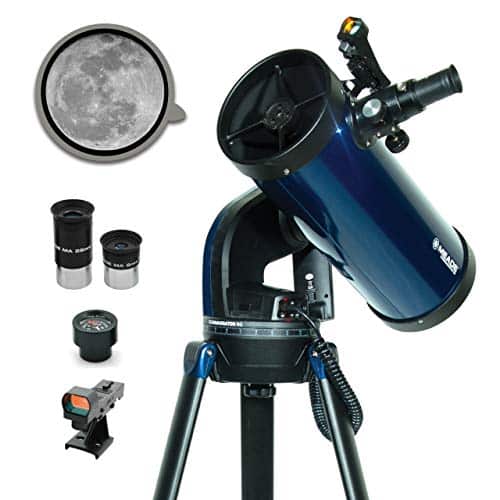
It also offers an auto-guidance system, with a fascinating “tour” function, when the telescope finds various objects in the sky and tells about them one by one.
Buy Meade StarNavigator NG 130mm Telescope on Amazon for $765.99 Today.
Review
I bought it as a planetary – the same Moon can be viewed in excellent detail. We liked both eyepieces for their quality.
Pros:
- Computerized guidance
- Convenient transportation
- Good magnification range (up to 260x)
Cons:
- Average aperture
- Simple finder (“red dot”)
Best Catadioptric Telescopes
Catadioptrics (or mirror-lens telescopes) combine elements of both reflectors and refractors. With the same technical characteristics, such telescopes are more compact. Their essential feature is a sufficiently good quality of the observed image without distortion and coloration.
Compared to all other telescopes, they are distinguished by their high cost. In addition to the price, there is one more feature – a long time of thermal stabilization. Therefore, before starting observations, such a telescope needs to stand outside for a while to cool down.
I can say that catadioptric telescopes are ideal for “thoughtful” observation and for taking photographs of the starry sky or space objects. Still, they are entirely unsuitable for beginners and young astronomers. For pros in astrophotography, here are the two best models are chosen by our experts.
1. Sky-Watcher AZ-GTI – Portable Computerized GOTO Alt-AZ Mount
It is a rather exciting and even more or less affordable model by the standards of its class. It is an automatic azimuth mount with a step of less than an angular second (but without a manual drive along the axes), a focal length of 1500 mm when using a 127 mm lens.
The tube weighs only 3.3 kilograms – if you are not afraid of the price and not the best aperture (f/11.8), this telescope will be of interest just for field observations and astrophotography.
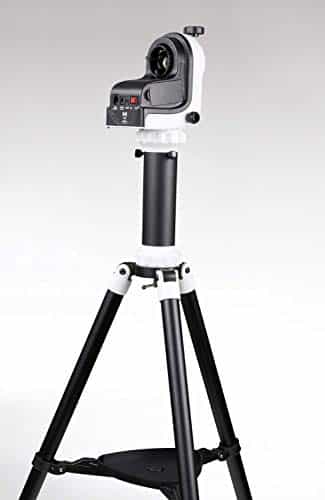
The manufacturer puts two eyepieces in the kit – 10 and 25 mm. They have the most standard 1.25-inch mount, and the viewfinder is sixfold.
It is clear that the pipe determines a considerable part of the price of a telescope, and not just the mount, but still, spending more than $460; you want something more monumental. Although, given the small weight of the pipe, this is not as sensitive as with a heavier reflector. But when the camera is installed on the T-mount, it can already start to strain.
Buy Sky-Watcher AZ-GTI on Amazon for $464 Today.
Reviews
I chose it primarily because of its size and weight, I often have to carry it in my hands, and with ordinary reflectors, it gets tired.
Pros:
- Small dimensions and weight of the pipe
- Two eyepieces included
- Automated mount
Cons:
- No manual drive on the mount
- Moderate aperture
2. Sky Watcher Skymax 127mm Maksutov-Cassegrain
Our rating of the best telescopes is continued by the relatively inexpensive “204-fold”, made according to the Maksutov-Cassegrain scheme, weighing less than 10 kilograms. It is perfect for regular “outings in the field.”
At the same time, its azimuth mount has full-fledged auto-guidance, so when taking pictures at long exposures, there is no need to fear that a clear image will turn into a stretched track.
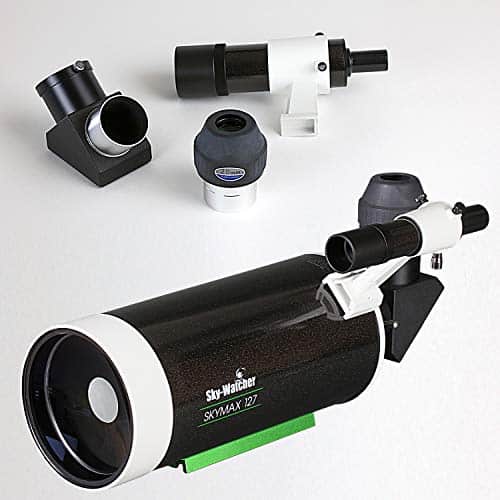
Due to a small aperture, the inevitable payoff for the compactness and low weight is a drop-in aperture: the relative aperture is only f/12.7. In addition, the bearing capacity of the mount is also typical, so it will not be suitable for installing a heavy camera with a highly sensitive matrix.
A telescope is ideal for observing or photographing bright objects with a tiny camera or smartphone; bearing the capacity of the mount.
Buy Sky-Watcher Skymax 127mm on Amazon for $1077.99 Today.
Reviews
An ordinary catadioptric – it will do for acquaintance with astronomy.
Pros:
- Easy transportation even on foot
- The presence of auto guidance
Cons:
- Average aperture, despite the relatively low magnification.
Best Chromospheric Telescopes
A Chromospheric telescope contains an input lens, a field lens, an interference-polarization filter installed in the telecentric path of beams, a projection system, and a photodetector characterized in that the input lens the projection system are mirrored.
The interference-polarization filter is installed at an angle to the telescope’s optical axis to coincide with the central reflected beam. Chromospheric telescopes are designed to study the solar chromosphere. These are not widely used in astrophotography; here is the best one chosen by our experts for sky & planet explorers.
1. Sky-Watcher Flextube 300 SynScan Dobsonian
Specialized telescopes for observing the Sun are a specific thing, and not the most demanded, therefore there is not much choice in our market. Of the few presented models, the Solar Quest telescope is the most attractive, which is why it took, in splendid isolation, the only position in this section of the rating.
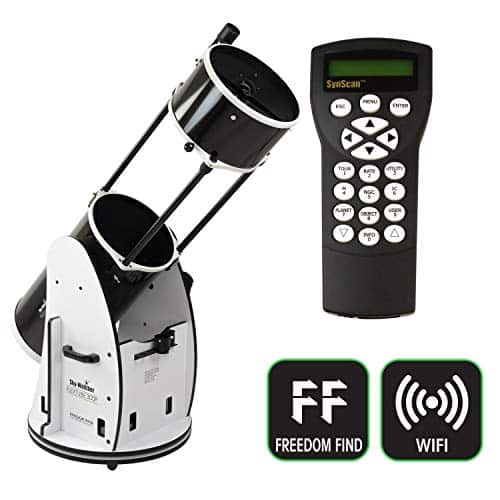
The proprietary Freedom Find Solar auto-guidance system is as easy to use as possible: after turning on, the telescope automatically aims at the Sun, after which it remains only to focus the optics – for this, it is worth saying “thanks” to the built-in GPS receiver and a three-axis accelerometer, thanks to which the system can automatically calculate the position of the Sun at a specific time for one particular location, even if the tripod is at a certain angle.
The 70mm lens does not provide the most impressive aperture for this 140x (only f/7), but just for Chromospheric telescopes, this is not so important: something, but the Sun has enough light. Therefore, a small competition allowed us to give the telescope first place: it is excellent for observing even the most complete beginners, and more experienced amateur astronomers will not disappoint in quality.
Buy Sky-Watcher Flextube 300 SynScan Dobsonian on Amazon for $3040.19 Today.
Reviews
Watching the Sun is convenient and exciting. It is a pity you cannot remove the filter to turn into a regular telescope – “foolproof.”
Pros:
- Extremely easy targeting
- Small size and weight
- Two eyepieces included
Cons:
- Fixed solar filter
Buying Guide for Beginners
A more or less detailed article on the features of various designs would require inflating the scope of our review at times, so we will have to go “to the top.”
Let’s start with the optical layout:
Lens (refractor) telescopes, in fact, overgrown telescopes, are simple in design and, therefore, affordable. Requirements for thermal stabilization are minimal of all design options. But the inevitable reckoning for the high magnification is a considerable length; large-diameter lenses have to be used to increase the aperture ratio, which ultimately makes the size of the telescope unsuitable for transportation, and the requirements for the quality of the mount are growing significantly.
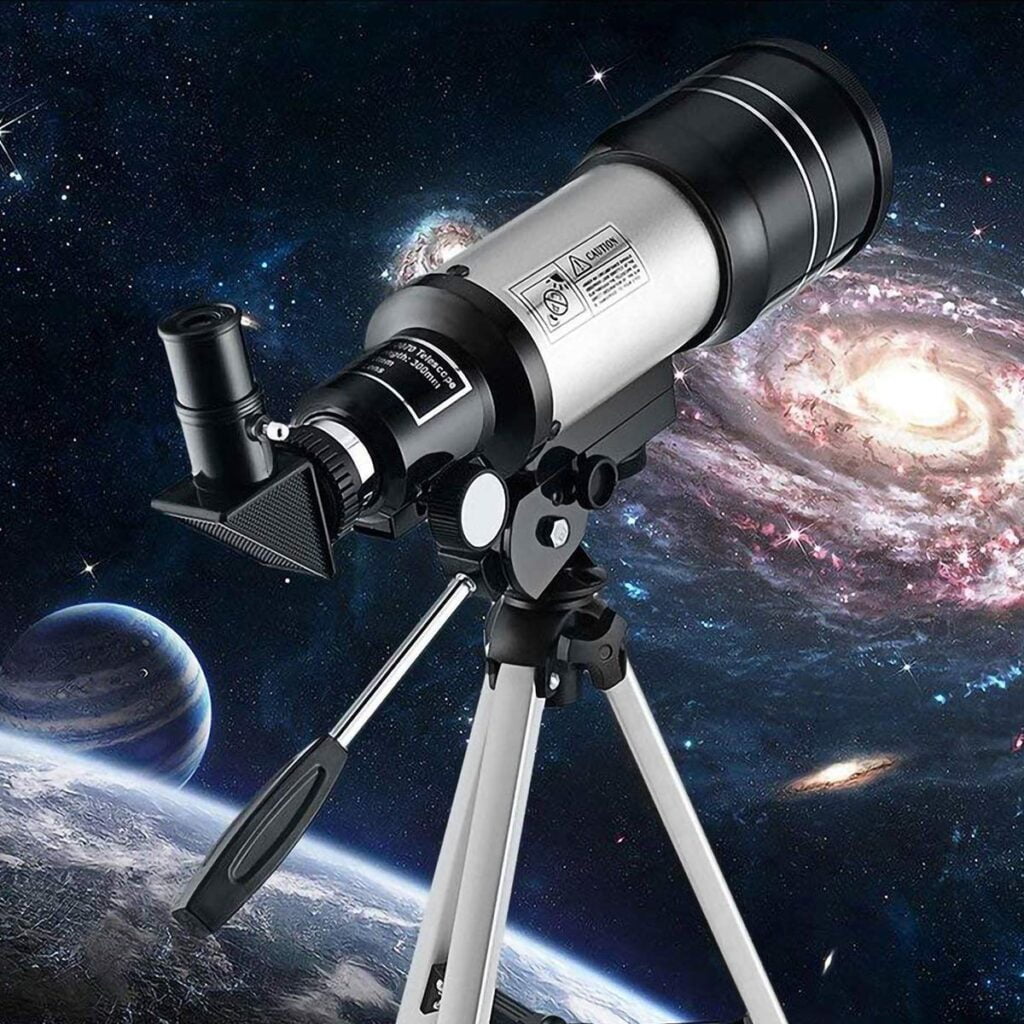
Reflector (Mirror) telescopes can be assembled according to several schemes, of which, nevertheless, Newton’s method has been the most popular for more than a century. These are captivating with much greater compactness – their length is several times less than that of refractory ones, having an equal focal length.
It is these telescopes that are most often bought as portable. Their aperture is higher than refractory ones, which means that they are better suited for viewing weakly luminous objects in the depths of space and for astrophotography. But their price is also higher, the influence of temperature is felt stronger, adjustment is more complicated.
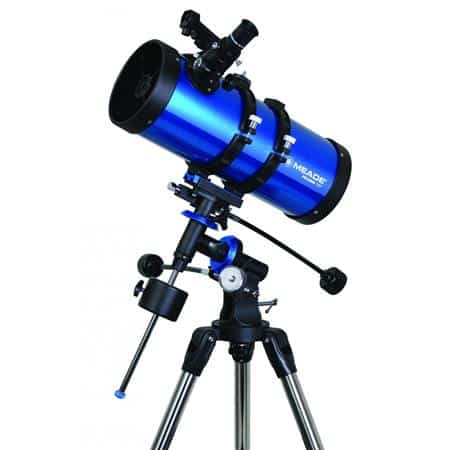
Catadioptric telescopes are a kind of hybrid of a mirror and lens design. They are even more compact, and this layout is excellent for high-power telescopes. The image quality is also superior to that of conventional reflex telescopes. But you have to pay for this both literally (in the store) and figuratively – they still have the highest thermal stabilization requirements, and adjustment is challenging.
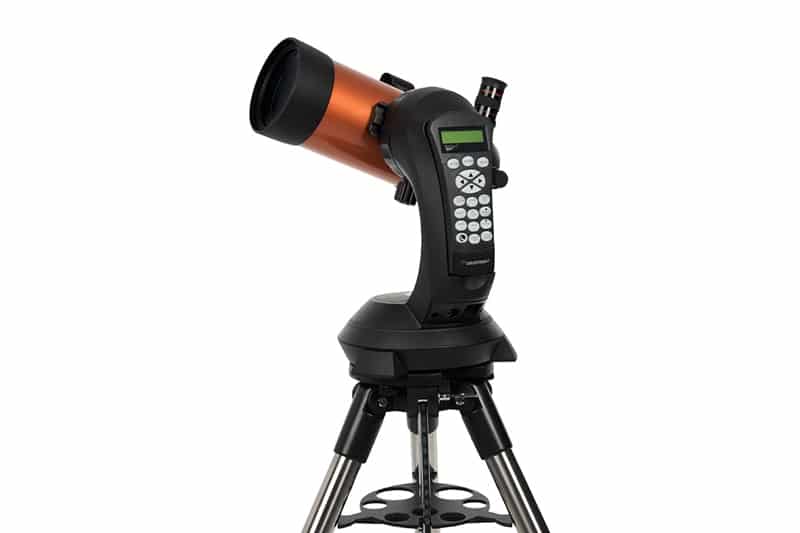
The telescope mount is the part that moves it relative to the tripod. On models with auto-guidance, it provides the ability to automatically track the selected object, which is very useful, especially at high magnifications. Here, even giant planets of the Solar System will move in the field of view at a noticeable speed and quickly disappear from it.
The simplest option is an alt-azimuth mount, very similar to the mount for cameras on conventional tripods. It is simple in design and easy to learn, but it has several disadvantages mentioned in the rating. Better equatorial mount already requires some fuss at the beginning of work – you will have to set the telescope’s polar axis.
But it works excellent with objects moving in the zenith region, and tracking in it is kinematically easier. Its kinematics does not work only near the poles – you understand that this drawback does not matter for amateur astronomers.
In any case, for the mount, regardless of the type, minimal backlash and accuracy of the mechanisms are very important; otherwise, with a light touch, the aiming will already “go away,” while moving the field of view will shake.
In the most complex mounts, the control electronics even consider backlash and uneven movement of mechanisms, but their price is very high.
Mounts also have their weight limits – keep in mind that when taking astrophotography, you will have to take into account the weight of the camera not to exceed the allowed threshold.
You may also like to read: Equipment Features and Choice of Best Objects for Astrophotography.
Frequently Asked Questions

Q1: I want to buy a telescope for a child. Which one to buy?
Answer: For a child, a special children’s telescope is perfect – many manufacturers produce such. Usually, these are inexpensive and relatively simple refractor instruments with an azimuth mount, with the help of which one can observe the Moon and the planets of the solar system.
Q2: Why are filters needed?
Answer: Filters for telescopes are needed to view a specific object in all details and with maximum quality: the Moon or a particular planet. The filters can be designed for near and deep space but are only suitable for those who know what they want to look at.
